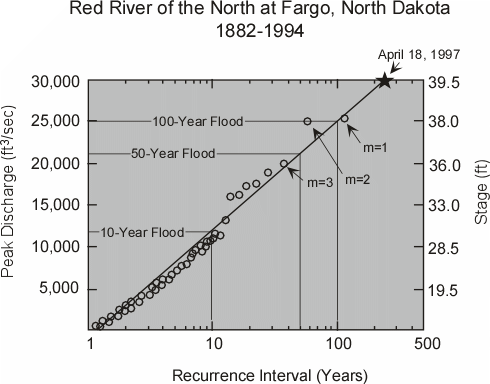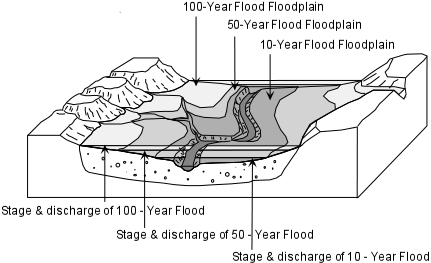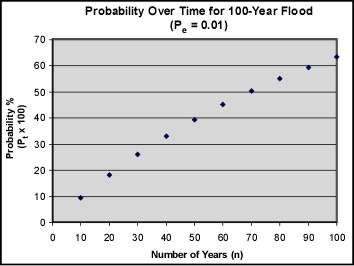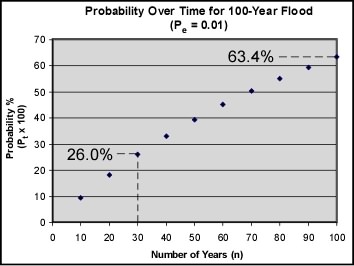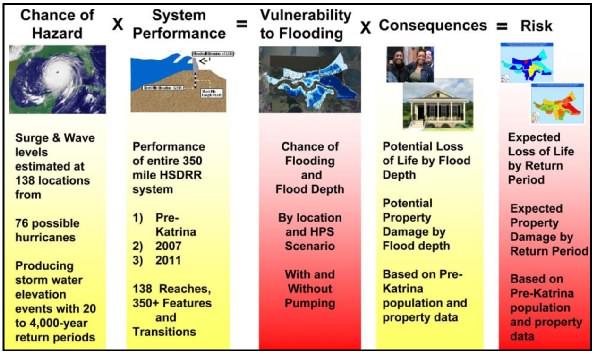For an area like New Orleans which is surrounded by levees and is composed of many sub-basins that need to be pumped out, the level of flooding is further complicated by such factors as
The Interagency Performance Evaluation Task Force (IPET) formed after Hurricane Katrina, undertook a risk analysis study that can be found in several different forms on the internet.
As Volume VIII of the IPET Final Report.
A general description of the results of this study can also be found at this site (direct link below).
Pre-Katrina
The New Orleans area was highly vulnerable to flooding from moderate to large hurricanes and exposed to very high risk of loss of life and property.
Any event beyond the 50-year frequency of occurrence (2%
chance of occurring each year) could produce significant flooding and losses.
Large events such as the 100-year (1% chance each year) flood would cause extensive flooding and losses.
Extreme events like the 500-year (0.2% chance each year) flood would totally devastate the entire region.
Current (2007)
Improvements and repairs made since Katrina reduced vulnerability to flooding for a number of areas, particularly those areas (largely portions of Orleans Metro and Jefferson East) that benefited by the placement of the temporary gates at the ends of the outfall canals.
Many areas remain highly vulnerable to flooding from larger storms (100-year).
The greatest vulnerability is in the areas surrounding the Inner Harbor Navigation Canal and on the West Bank where a number of sections had no protective structures.
Extreme events would still totally devastate the area.
With 100 Year Protection System in Place (2011)
Dramatic reduction in vulnerability to flooding for a majority of the region.
In this system status, a 100-year flood event is largely the result of heavy rainfall, not overtopping or breaching from hurricane
surge.
This system would also significantly reduce vulnerability of flooding for extreme events up to the 500-year event; however, some areas could experience significant flooding and losses.
Given similar evacuation conditions as in Katrina, the 2011 system (with significant online pumping capability during the storm)
could reduce potential loss of life by as much as 97% for the 100-year flood event.
The 100-year System also dramatically reduces potential for loss of life from a 500-year flood event.
Given the same property distribution and value that existed prior to Katrina, the 100-year system would reduce direct property damages by 75% for the 100-year flood event and up to 75% for the 500-year flood event.
This benefit is directly attributed to the reduction of the severity of the 100-year and 500-year floods.
Importance of Pumping
Pumping capability during storm events is a crucial component of
flood risk mitigation.
For the 100-year flood event, pumping equivalent to approximately
50% of the ideal capacity of existing pumps can reduce potential loss of life by approximately half for the 2007 system and up to 80% for the 2011 system.
Direct property losses from the 100-year flood can be reduced by up to 25% for the 2007 system.
For the 100-year system, up to 75% For the 500-year flood event, pumping can reduce loss of life potential by up to 50% and property losses by about 40% when the 2011 system is in place.
100% Risk Reduction Will Never Be Achieved No Matter How Large the Levees or Floodwalls
A 100-year system such as that planned for 2011 in New Orleans, should be considered a baseline, not an end-state, for an urban area.
There is still considerable risk from extreme events.
Risk reduction must be coupled with additional measures, structural and non-structural, that address the principal sources of the remaining residual risk.
For example: more effective evacuation or emergency response to reduce exposure of people to flooding, or flood proofing, compartmentalization or landuse zoning to reduce property damages.
The IPET Risk Assessment Model is shown in Figure 5.
